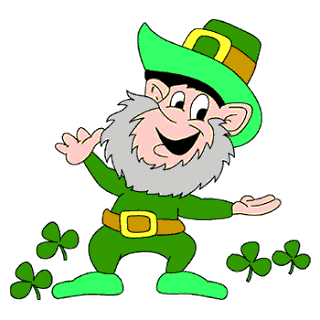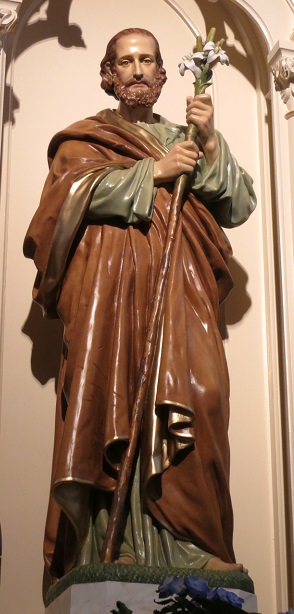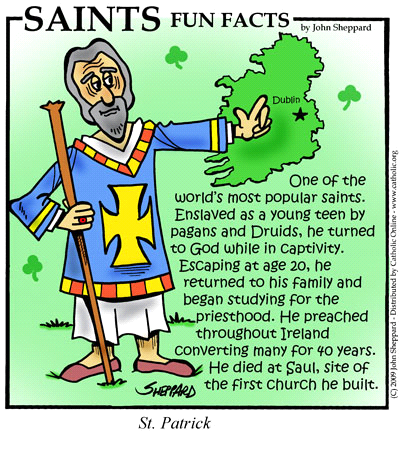
Who Was Saint Patrick?
 A biography of the Irish Saint
A biography of the Irish Saint
Saint Patrick was a fifth-century (400's) British
Christian missionary to and bishop in Ireland. Credited with
spreading the popularity of Christianity in Ireland, he is considered
the "Apostle of Ireland". And while he is the primary patron saint of
Ireland, along with saints Brigit of Kildare and Columba, he is not a
Saint with a capital "S", meaning a cannonized Saint. He is
also reveredin the Anglican Communion, the Old Catholic Church and in
the Eastern Orthodox Church.
The only name that Patrick used for
himself in his own writings is Pātricius, which gives Old Irish
Pátraic and thus modern, English Patrick and Welsh Padrig.
Facts in chronological order
- Born: 387
- His grandfather had been a priest, and his father a town councilor, but as a child, he wasn't religious.
- At age 14, in the year 405, Patrick was captured in a raid by Irish pirates and taken as a slave to pagan Ireland. At the time, Ireland was a land of Druids and pagans
- At age 20, after six years of bondage, forced to tend to sheep, he had a dream that told him to esacpe, and he did, and returned to Scotland.
- A few years after returning home, Patrick saw a vision that convinced him to study for the priesthood. He was ordained by St. Germanus, the Bishop of Auxerre, whom he had studied under for years, and was later ordained a bishop and sent to take the Gospel to Ireland.return to Ireland as a missionary.
- He was in his mid-40s when he returned to Ireland. Patrick arrived in Slane, Ireland on March 25, 433
- He then converted his former master, Milchu, who was a Druid clan chieftain, to Christianity. Then set about converting the other chieftains.
- He converted many people and he began building churches across the country..
- He often used shamrocks to explain the Holy Trinity, which explains the significance of shamrocks in Irish culture.
- Patrick preached and converted all of Ireland for 40 years.
- Those were hard years, St. Patrick's position as a foreigner in Ireland meant legally he was without protection, and he says that he was on one occasion beaten, robbed of all he had, and put in chains, perhaps awaiting execution.
- After years of living in poverty, traveling and enduring much suffering he died at Saul.
- Died: 461
- A variety of dates are given for his death.from 457 to March 17, 461.
- He is believed to be buried in Down Cathedral, Downpatrick. His grave was marked in 1990 with a granite stone.
Myths and misconceptions
- Saint Patrick didn't really drive the snakes out of Ireland. There never were any. But it may have been a metaphor for driving out evil.
- St. Patrick was't Irish; he was from Dumbarton, Scotland.
- Patrick's walking stick grows into a living tree(More likely, he stuck his walking stick into the ground and preached for so long that people joked it started to grow.
- Wikipedia tells us; "A recent alternative interpretation of
Patrick's departure to Ireland suggests that as the son of a
decurion he would have been obliged by Roman law to serve on the
town council (curia), but chose instead to abscond from the
onerous obligations of this office by fleeing abroad, as many
others in his position had done in what has become known as the
'flight of the curiales'.[86] However, according to Patrick's
own account, it was the raiders who brought him to Ireland where
he was enslaved and held captive for six years.[87] Roy Flechner
also asserts the improbability of an escape from servitude and
journey of the kind that Patrick purports to have undertaken. He
also draws attention to the biblical allusions in Patrick's own
account (e.g. the topos of freedom after six years of servitude
in Exod. 21:2 or Jer. 34:14), which imply that perhaps parts of
the account may not have been intended to be understood
literally.[88]"
Other holidays and resources:
- Easter egg hunts - near you!
- Find local children's consignment sales
- Road tripping and camping tips, tricks and destinations
- Local Pick Your Own farms
- Environmental resources
- Consumer protection resources
- Farm markets and roadside stands
- Local fruit and vegetable festivals
- Local Honey
- Valentine's Day info and resources
- Local meats, milk, eggs
- Pumpkin patches
- Corn mazes
- Christmas Tree Farms & lots
- Traditional Green Plaid Kilt in Adult (men or women) Standard Size - Perfect for St. Patrick's Day and Irish Festivals & Celebration
- Womens Kilt Mini Skirt, Green Plaid
- Women's short kilt: Lucky Irish Green St. Patrick's Day Plaid Kilt, One Size
- Lingerie Lace Babydoll 2-Piece Sexy Bra and Panty Sets
- Green leprechaun hat and green beard on Amazon
- Perfect for St. Pat's Day: Beautiful Green Summer Pleated Spaghetti Strap Sleeveless Camisole Loose Fit Tank Tops for Women on Amazon
- Attractive, Classy, Sexy Women's Leprechaun Costume on Amazon
- Women's green Lingerie Lace Babydoll Chemise Halter Teddy Mesh Nightgown on Amazon
- St. Patrick's Day T-Shirt for Boys & Girls "Lucky Charmer" on Amazon
- St. Patrick’s Day Shamrock Green Velvet Top Hat for Men & Women on Amazon